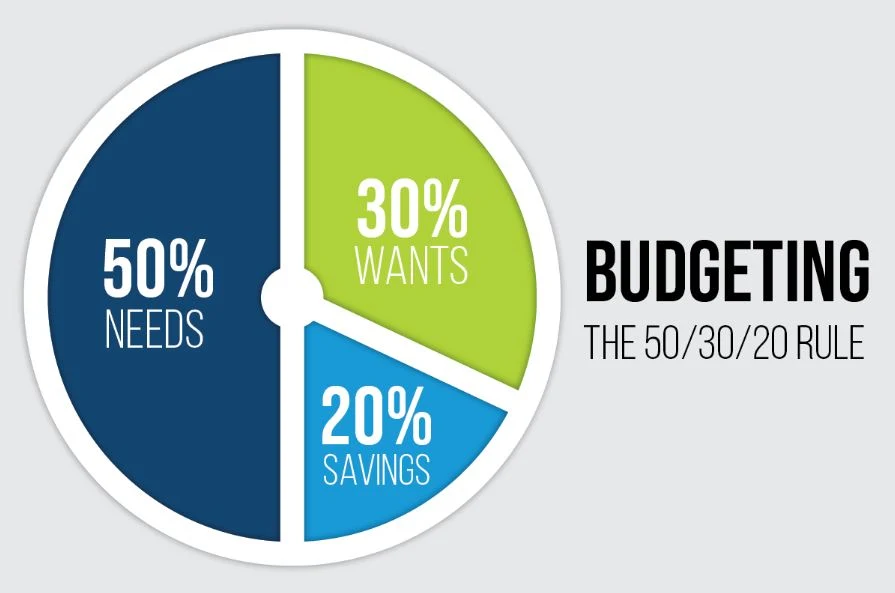The 50/30/20 rule of budgeting is a simple yet effective method for managing personal finances. This rule divides your after-tax income into three categories: 50% for needs, 30% for wants, and 20% for savings and debt repayment. In this guide, we will explore the 50/30/20 rule in detail, providing examples and tips to help you effectively implement this budgeting strategy.
Understanding the 50/30/20 Rule
50% for Needs
Needs are essential expenses that you must cover to live and work. These include:
- Housing: Rent or mortgage payments.
- Utilities: Electricity, water, and heating.
- Groceries: Essential food and household items.
- Transportation: Car payments, fuel, public transport, and maintenance.
- Insurance: Health, auto, and home insurance.
- Healthcare: Necessary medical expenses and medications.
- Minimum debt payments: Minimum payments on credit cards and loans.
Example: If your monthly after-tax income is $3,000, you should allocate $1,500 towards needs.
30% for Wants
Wants are non-essential expenses that enhance your lifestyle. These include:
- Dining out: Restaurants, coffee shops, and takeout.
- Entertainment: Movies, concerts, hobbies, and subscriptions.
- Travel: Vacations and weekend getaways.
- Shopping: Clothes, electronics, and luxury items.
- Personal care: Spa treatments, gym memberships, and beauty products.
Example: With a monthly after-tax income of $3,000, you can allocate $900 towards wants.
20% for Savings and Debt Repayment
This category focuses on building financial security and reducing debt. It includes:
- Emergency fund: Savings for unexpected expenses.
- Retirement savings: Contributions to retirement accounts like 401(k) or IRA.
- Debt repayment: Paying off credit card balances, student loans, and other debts.
- Investments: Stocks, bonds, and other investment vehicles.
Example: From a $3,000 monthly income, $600 should go towards savings and debt repayment.
Benefits of the 50/30/20 Rule
Simplicity and Flexibility
The 50/30/20 rule is straightforward, making it easy to implement and stick to. It allows for flexibility in adjusting your budget as your financial situation changes.
Financial Balance
This rule ensures a balanced approach to spending and saving. It helps you cover essential expenses, enjoy life, and secure your financial future.
Debt Reduction
Allocating 20% of your income to savings and debt repayment helps you systematically pay down debt, reducing financial stress over time.
Long-term Savings
By consistently saving 20% of your income, you build a solid financial foundation, preparing for emergencies and retirement.
Practical Tips for Implementing the 50/30/20 Rule
Track Your Expenses
Use budgeting apps or spreadsheets to track your spending. This will help you identify areas where you can cut back and ensure you stay within the 50/30/20 guidelines.
Adjust Your Categories
Life circumstances change, and so should your budget. If you have high debt, you might allocate more than 20% to debt repayment initially and reduce your wants category temporarily.
Prioritize Debt Repayment
Focus on high-interest debt first, such as credit card balances. Reducing these debts quickly will free up more money for savings and wants in the future.
Automate Savings
Set up automatic transfers to your savings and retirement accounts. This ensures you consistently save and reduces the temptation to spend.
Review Regularly
Review your budget monthly to ensure you are on track. Adjust as needed to accommodate changes in income or expenses.
Examples of the 50/30/20 Rule in Action
Example 1: Single Professional
- Income: $4,000/month after tax
- Needs (50%): $2,000 (Rent: $1,200, Utilities: $200, Groceries: $300, Transportation: $200, Insurance: $100)
- Wants (30%): $1,200 (Dining out: $300, Entertainment: $200, Travel: $400, Shopping: $200, Personal care: $100)
- Savings and Debt Repayment (20%): $800 (Emergency fund: $200, Retirement: $300, Debt repayment: $300)
Example 2: Family of Four
- Income: $6,000/month after tax
- Needs (50%): $3,000 (Mortgage: $1,500, Utilities: $300, Groceries: $600, Transportation: $400, Insurance: $200)
- Wants (30%): $1,800 (Dining out: $400, Entertainment: $300, Travel: $600, Shopping: $300, Personal care: $200)
- Savings and Debt Repayment (20%): $1,200 (Emergency fund: $400, Retirement: $400, Debt repayment: $400)
Conclusion
The 50/30/20 rule of budgeting is a practical and effective way to manage your finances. By dividing your income into needs, wants, and savings/debt repayment, you ensure a balanced approach to spending and saving.
With the simplicity and flexibility of this rule, you can easily adapt it to your financial situation and goals. Start implementing the 50/30/20 rule today to take control of your finances and build a secure financial future.















0 Comments
Liked? Encourage me by adding a comment or suggestion